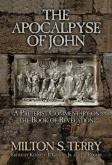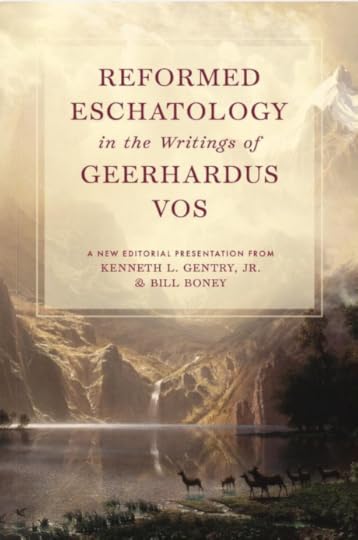VOS ON THE RESURRECTION-BODY
 PMW 2024-073 by Geerhardus Vos
PMW 2024-073 by Geerhardus Vos
Gentry Note:
This is part 2 of a two-part study on the believer’s resurrection by Geerhardus Vos. Vos is helpful for countering the heretical arguments of some who deny or greatly alter the historic Christian doctrine of the resurrection of the body. The only changes I will make to Vos’ article is to break it into smaller paragraphs to make it easier to read for a modern audience.
VOS ON THE RESURRECTION BODY
The main passage informing us as to the nature of the resurrection body is 1 Corinthians 15:35–58. The difficulty Paul here seeks to relieve does not concern the substance of the future body, but its kind (compare 1 Corinthians 15:35 “With what manner of body do they come?”). Not until 1 Corinthians 15:50 is the deeper question of difference in substance touched upon. The point of the figure of “sowing” is not that of identity of substance, but rather this, that the impossibility of forming a concrete conception of the resurrection body is no proof of its impossibility, because in all vegetable growth there appears a body totally unlike that which is sown, a body the nature and appearance of which are determined by the will of God. We have no right to press the figure in other directions, to solicit from it answers to other questions.
That there is to be a real connection between the present and the future body is implied rather than directly affirmed. 1 Corinthians 15:36 shows that the distinction between the earthly body and a germ of life in it, to be entrusted with it to the grave and then quickened at the last day, does not lie in the apostle’s mind, for what is sown is the body; it dies and is quickened in its entirety. Especially the turn given to the figure in 15:37—that of a naked grain putting on the plant as a garment—proves that it is neither intended nor adapted to give information on the degree of identity or link of continuity between the two bodies. The “bare grain” is the body, not the spirit, as some would have it (Teichmann), for it is said of the seed that it dies; which does not apply to the Pneuma (compare also 15:44). The fact is that in this entire discussion the subjective spirit of the believer remains entirely out of consideration; the matter is treated entirely from the standpoint of the body. So far as the Pneuma enters into it, it is the objective Spirit, the Spirit of Christ.
THE APOCALYPSE OF JOHN
by Milton S. Terry
This book is Terry’s preterist commentary on the Book of Revelation. It was originally the last half of his much larger work, Biblical Apocalyptics. It is deeply-exegetical, tightly-argued, and clearly-presented.
For more study materials: https://www.kennethgentry.com/
As to the time of the sowing, some writers take the view that this corresponds to the entire earthly life, not to the moment of burial only (so already Calvin, recently Teichmann and Charles). In 15:42, 43 there are points of contact for this, inasmuch as especially the three last predicates “in dishonor,” “in weakness,” “a natural body,” seem more applicable to the living than to the dead body. At any rate, if the conception is thus widened, the act of burial is certainly included in the sowing. The objection arising from the difficulty of forming a conception of the resurrection body is further met in 15:39–41, where Paul argues from the multitude of bodily forms God has at His disposal. This thought is illustrated from the animal world (15:39); from the difference between the heavenly and the earthly bodies (15:40); from the difference existing among the heavenly bodies themselves (15:41).
The structure of the argument is indicated by the interchange of two words for “other,” allos and heteros, the former designating difference of species within the genus, the latter difference of genus, a distinction lost in the English version. In all this the reasoning revolves not around the substance of the bodies but around their kind, quality, appearance (sarx in 15:39 = soma, “body,” not = “flesh”). The conclusion drawn is that the resurrection body will differ greatly in kind from the present body. It will be heteros, not merely allos.
Reformed Eschatology in the Writings of Geerhardus Vos
Ed. by Ken Gentry and Bill Boney
This is a collection of several key eschatological studies by the renowned Reformed theologian Geehardus Vos. We have modernized Vos’ grammar and syntax and updated his layout style according to modern publishing conventions (shorter sentences and paragraphs). We did this without changing any of Vos’ arguments.
For information on the upcoming Geerhardus Vos work or to pre-order it, see:
https://axeheadpress.com/pages/coming-soon-vos
The points of difference are enumerated in 15:42, 43. Four contrasts are named; the first three in each case appear to be the result of the fourth. The dominating antithesis is that between the soma psuchikon and the soma pneumatikon. Still Paul can scarcely mean to teach that “corruption,” “dishonor,” “weakness” are in the same sense necessary and natural results of the “psychical” character of the earthly body, as the corresponding opposites are necessary and natural concomitants of the pneumatic character of the resurrection body. The sequel shows that the “psychical body” was given man at creation, and according to 15:53 corruption and death go together, whereas death is not the result of creation but of the entrance of sin according to Paul’s uniform teaching elsewhere.
Olivet Discourse Made Easy (by Ken Gentry)
Verse-by-verse analysis of Christ’s teaching on Jerusalem’s destruction in Matt 24. Shows the great tribulation is past, having occurred in AD 70, and is distinct from the Second Advent at the end of history. Provides exegetical reasons for a transition from AD 70 to the Second Advent at Matthew 24:36.
See more study materials at: www.KennethGentry.com
Hence, also the predicate sarkikos is avoided in 15:46, 47, where the reference is to creation, for this word is always associated in Paul with sin. The connection, therefore, between the “natural (psychical, margin) body” and the abnormal attributes conjoined with it, will have to be so conceived, that in virtue of the former character, the body, though it need not of itself, yet will fall a prey to the latter when sin enters. In this lies also the explanation of the term “psychical body.” This means a body in which the psuche, the natural soul, is the vitalizing principle, sufficient to support life, but not sufficient to that supernatural, heavenly plane, where it is forever immune to death and corruption.
The question must be asked, however, why Paul goes back to the original state of man’s body and does not content himself with contrasting the body in the state of sin and in the state of eternal life. The answer is found in the exigency of the argument. Paul wished to add to the argument for the possibility of a different body drawn from analogy, an argument drawn from the typical character of the original creation-body. The body of creation, on the principle of prefiguration, pointed already forward to a higher body to be received in the second stage of the world-process: “if there exists a psychical body, there exists also a pneumatic body” (15:44). The proof lies in Genesis 2:7.
Some think that Paul here adopts the Philonic doctrine of the creation of two men, and means 1 Corinthians 15:45 b as a quotation from Genesis 1:27. But the sequence is against this, for Paul’s spiritual man appears on the scene last, not first, as in Philo. Nor can the statement have been meant as a correction of Philo’s sequence, for Paul cannot have overlooked that, once a double creation were found in Genesis 1 and 2, then Philo’s sequence was the only possible one, to correct which would have amounted to correcting Scripture. If Paul does here correct Philo, it must be in the sense that he rejects the entire Philonic exegesis, which found in Genesis a twofold creation (compare 1 Corinthians 11:7).
Evidently for Paul, Genesis 2:7 taken by itself contains the proof of his proposition, that there is both a psychical and a pneumatic body. Paul regarded the creation of the first Adam in a typical light. The first creation gave only the provisional form in which God’s purpose with reference to man was embodied, and in so far looked forward to a higher embodiment of the same idea on a higher pneumatic plane (cf. Romans 5:14): “The first man is of the earth, earthy: the second man is of heaven” (1 Corinthians 15:47); “of” or “from heaven” does not designate heavenly material, for even here, by not giving the opposite to choikos, “earthly,” Paul avoided the question of substantiality.
A “pneumatic” body is not, as many assume, a body made out of pneuma as a higher substance, for in that case Paul would have had pneumatikon ready at hand as the contrast to choikon. Only negatively the question of substance is touched upon in 1 Corinthians 15:50: “Flesh and blood cannot inherit the kingdom of God,” but the apostle does not say what will take their place. Compare further, for the non-substantial meaning of pneumatikos, Romans 15:27; 1 Corinthians 9:11; 10:3; Ephesians 1:3; 5:19; 6:12; Colossians 1:9. The only positive thing which we learn in this direction is formal, namely, that the resurrection body of the believer will be the image of that of Christ (1 Corinthians 15:49).
Click on the following images for more information on these studies:



Kenneth L. Gentry Jr.'s Blog
- Kenneth L. Gentry Jr.'s profile
- 85 followers



